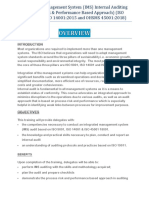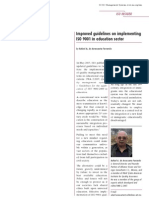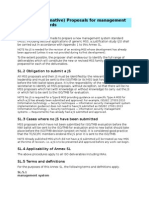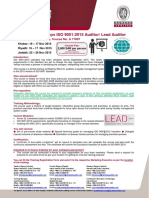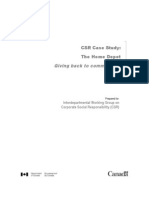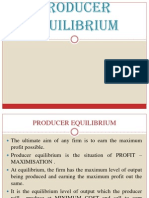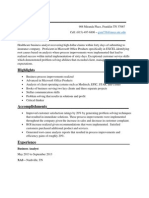Iso 9001 Quality Management Standard
Iso 9001 Quality Management Standard
Uploaded by
selinasimpson321Copyright:
Available Formats
Iso 9001 Quality Management Standard
Iso 9001 Quality Management Standard
Uploaded by
selinasimpson321Original Title
Copyright
Available Formats
Share this document
Did you find this document useful?
Is this content inappropriate?
Copyright:
Available Formats
Iso 9001 Quality Management Standard
Iso 9001 Quality Management Standard
Uploaded by
selinasimpson321Copyright:
Available Formats
Iso 9001 quality management standard
In this file, you can ref useful information about iso 9001 quality management standard such as
iso 9001 quality management standardforms, tools for iso 9001 quality management standard, iso
9001 quality management standardstrategies If you need more assistant for iso 9001 quality
management standard, please leave your comment at the end of file.
Other useful material for iso 9001 quality management standard:
qualitymanagement123.com/23-free-ebooks-for-quality-management
qualitymanagement123.com/185-free-quality-management-forms
qualitymanagement123.com/free-98-ISO-9001-templates-and-forms
qualitymanagement123.com/top-84-quality-management-KPIs
qualitymanagement123.com/top-18-quality-management-job-descriptions
qualitymanagement123.com/86-quality-management-interview-questions-and-answers
I. Contents of iso 9001 quality management standard
==================
What is ISO 9001?
ISO 9001 is the internationally recognised standard for the quality
management of businesses. It prescribes systematic control of activities to
ensure that the needs and expectations of customers are met. It is
designed and intended to apply to virtually any product or service, made by
any process anywhere in the world.
The Benefits of implementing ISO 9001
Implementing a Quality Management System will motivate staff by defining
their key roles and responsibilities. Cost savings can be made through
improved efficiency and productivity, as product or service deficiencies will
be highlighted. From this, improvements can be developed, resulting in less
waste, inappropriate or rejected work and fewer complaints. Customers will
notice that orders are met consistently, on time and to the correct
specification. This can open up the market place to increased
opportunities.
Why seek certification to ISO 9001?
Registration to ISO 9001 by an accredited certification body shows
committed to quality, customers, and a willingness to work towards
improving efficiency.
It demonstrates the existence of an effective quality management system
that satisfies the rigours of an independent, external audit.
An ISO 9001 certificate enhances company image in the eyes of
customers, employees and shareholders alike.
It also gives a competitive edge to an organizations marketing.
How do you start to implement ISO 9001? What is
involved?
Once all the requirements of ISO 9001 have been met, it is time for an
external audit.
Identify the requirements of ISO 9001 and how they apply to the
business involved.
Establish quality objectives and how they fit in to the operation of the business.
Produce a documented quality policy indicating how these requirements are satisfied.
Communicate them throughout the organization.
Evaluate the quality policy, its stated objectives and then prioritize requirements to ensure
they are met.
Identify the boundaries of the management system and produce documented procedures
as required.
Ensure these procedures are suitable and adhered to.
Once developed, internal audits are needed to ensure the system carries on working.
Audit to ISO 9001
Once all the requirements of ISO 9001 have been met, it is time for an external audit.
This should be carried out by a third party, accredited certification body (CB) such as ISOQAR.
In the USA, the CB should be accredited by ANAB. The chosen CB will review the quality
manuals and procedures. This process involves looking at the companys evaluation of quality
and ascertains if targets set for the management program are measurable and achievable. This is
followed at a later date by a full on-site audit to ensure that working practices observe the
procedures and stated objectives and that appropriate records are kept.
After a successful audit, a certificate of registration to ISO 9001 will be issued. There will then
be surveillance visits (usually once or twice a year) to ensure that the system continues to work.
This is covered in more detail in ISOQARs Audit Procedure information sheet. Please get in
touch if you would like a copy.
Why choose ISOQAR for your audit?
ISOQAR has an enviable record for customer satisfaction for its certification services. A friendly
approach and a dislike of bureaucracy has led to unprecedented growth through referrals from
contented clients. ISOQAR only employs auditors that have empathy with this approach. They
are also carefully allocated by their experience in the industry they are auditing. This results in a
practical, meaningful audit, carried out in an air of mutual understanding. ISOQAR firmly
believes that its audits should benefit the organization that requests it, not be an intellectual
exercise to please the auditor.
What is the cost of an audit to ISO 9001?
For a fixed, written quotation, we require a few details regarding your organization. These can be
submitted to ISOQAR via a short questionnaire or alternatively contact ISOQAR for more
details. Quotations are provided without any obligation.
Where to obtain further information or help
The actual standard can be obtained from the American Society for Quality (ASQ) on 800 248
1946 orwww.qualitypress.asq.org or the American National Standards Institute (ANSI) on 212
642 4900 orwww.ansi.org .
The Institute of Quality Assurance operates a Quality Information Centre. You may reach this
by going towww.iqa.org. Click on information centre then resources for information and
guidance.
Paton Press publishes a book called ISO 9001 In Plain English written by Craig Cochran.
Although it is Craigs own interpretation of the standard, it certainly makes for simplified
reading if you are new to the subject. Go to www.patonpress.com
An organization in Canada has translated ISO 9001 into plain English. Although it is their own
interpretation of the standard, it certainly makes for simplified reading if you are new to the
subject. Go towww.praxiom.com
Implementing ISO 9001
A document named ISO 9004 (obtainable as above) provides practical guidance and examples of
how to interpret the requirements of ISO 9001.
Training courses about how to put together a Quality Management System are also readily
available. Contact ISOQAR or Chambers of Commerce for more details.
==================
III. Quality management tools
1. Check sheet
The check sheet is a form (document) used to collect data
in real time at the location where the data is generated.
The data it captures can be quantitative or qualitative.
When the information is quantitative, the check sheet is
sometimes called a tally sheet.
The defining characteristic of a check sheet is that data
are recorded by making marks ("checks") on it. A typical
check sheet is divided into regions, and marks made in
different regions have different significance. Data are
read by observing the location and number of marks on
the sheet.
Check sheets typically employ a heading that answers the
Five Ws:
2. Control chart
Who filled out the check sheet
What was collected (what each check represents,
an identifying batch or lot number)
Where the collection took place (facility, room,
apparatus)
When the collection took place (hour, shift, day of
the week)
Why the data were collected
Control charts, also known as Shewhart charts
(after Walter A. Shewhart) or process-behavior
charts, in statistical process control are tools used
to determine if a manufacturing or business
process is in a state of statistical control.
If analysis of the control chart indicates that the
process is currently under control (i.e., is stable,
with variation only coming from sources common
to the process), then no corrections or changes to
process control parameters are needed or desired.
In addition, data from the process can be used to
predict the future performance of the process. If
the chart indicates that the monitored process is
not in control, analysis of the chart can help
determine the sources of variation, as this will
result in degraded process performance.[1] A
process that is stable but operating outside of
desired (specification) limits (e.g., scrap rates
may be in statistical control but above desired
limits) needs to be improved through a deliberate
effort to understand the causes of current
performance and fundamentally improve the
process.
The control chart is one of the seven basic tools of
quality control.[3] Typically control charts are
used for time-series data, though they can be used
for data that have logical comparability (i.e. you
want to compare samples that were taken all at
the same time, or the performance of different
individuals), however the type of chart used to do
this requires consideration.
3. Pareto chart
A Pareto chart, named after Vilfredo Pareto, is a type
of chart that contains both bars and a line graph, where
individual values are represented in descending order
by bars, and the cumulative total is represented by the
line.
The left vertical axis is the frequency of occurrence,
but it can alternatively represent cost or another
important unit of measure. The right vertical axis is
the cumulative percentage of the total number of
occurrences, total cost, or total of the particular unit of
measure. Because the reasons are in decreasing order,
the cumulative function is a concave function. To take
the example above, in order to lower the amount of
late arrivals by 78%, it is sufficient to solve the first
three issues.
The purpose of the Pareto chart is to highlight the
most important among a (typically large) set of
factors. In quality control, it often represents the most
common sources of defects, the highest occurring type
of defect, or the most frequent reasons for customer
complaints, and so on. Wilkinson (2006) devised an
algorithm for producing statistically based acceptance
limits (similar to confidence intervals) for each bar in
the Pareto chart.
4. Scatter plot Method
A scatter plot, scatterplot, or scattergraph is a type of
mathematical diagram using Cartesian coordinates to
display values for two variables for a set of data.
The data is displayed as a collection of points, each
having the value of one variable determining the position
on the horizontal axis and the value of the other variable
determining the position on the vertical axis.[2] This kind
of plot is also called a scatter chart, scattergram, scatter
diagram,[3] or scatter graph.
A scatter plot is used when a variable exists that is under
the control of the experimenter. If a parameter exists that
is systematically incremented and/or decremented by the
other, it is called the control parameter or independent
variable and is customarily plotted along the horizontal
axis. The measured or dependent variable is customarily
plotted along the vertical axis. If no dependent variable
exists, either type of variable can be plotted on either axis
and a scatter plot will illustrate only the degree of
correlation (not causation) between two variables.
A scatter plot can suggest various kinds of correlations
between variables with a certain confidence interval. For
example, weight and height, weight would be on x axis
and height would be on the y axis. Correlations may be
positive (rising), negative (falling), or null (uncorrelated).
If the pattern of dots slopes from lower left to upper right,
it suggests a positive correlation between the variables
being studied. If the pattern of dots slopes from upper left
to lower right, it suggests a negative correlation. A line of
best fit (alternatively called 'trendline') can be drawn in
order to study the correlation between the variables. An
equation for the correlation between the variables can be
determined by established best-fit procedures. For a linear
correlation, the best-fit procedure is known as linear
regression and is guaranteed to generate a correct solution
in a finite time. No universal best-fit procedure is
guaranteed to generate a correct solution for arbitrary
relationships. A scatter plot is also very useful when we
wish to see how two comparable data sets agree with each
other. In this case, an identity line, i.e., a y=x line, or an
1:1 line, is often drawn as a reference. The more the two
data sets agree, the more the scatters tend to concentrate in
the vicinity of the identity line; if the two data sets are
numerically identical, the scatters fall on the identity line
exactly.
5.Ishikawa diagram
Ishikawa diagrams (also called fishbone diagrams,
herringbone diagrams, cause-and-effect diagrams, or
Fishikawa) are causal diagrams created by Kaoru
Ishikawa (1968) that show the causes of a specific event.
[1][2] Common uses of the Ishikawa diagram are product
design and quality defect prevention, to identify potential
factors causing an overall effect. Each cause or reason for
imperfection is a source of variation. Causes are usually
grouped into major categories to identify these sources of
variation. The categories typically include
People: Anyone involved with the process
Methods: How the process is performed and the
specific requirements for doing it, such as policies,
procedures, rules, regulations and laws
Machines: Any equipment, computers, tools, etc.
required to accomplish the job
Materials: Raw materials, parts, pens, paper, etc.
used to produce the final product
Measurements: Data generated from the process
that are used to evaluate its quality
Environment: The conditions, such as location,
time, temperature, and culture in which the process
operates
6. Histogram method
A histogram is a graphical representation of the
distribution of data. It is an estimate of the probability
distribution of a continuous variable (quantitative
variable) and was first introduced by Karl Pearson.[1] To
construct a histogram, the first step is to "bin" the range of
values -- that is, divide the entire range of values into a
series of small intervals -- and then count how many
values fall into each interval. A rectangle is drawn with
height proportional to the count and width equal to the bin
size, so that rectangles abut each other. A histogram may
also be normalized displaying relative frequencies. It then
shows the proportion of cases that fall into each of several
categories, with the sum of the heights equaling 1. The
bins are usually specified as consecutive, non-overlapping
intervals of a variable. The bins (intervals) must be
adjacent, and usually equal size.[2] The rectangles of a
histogram are drawn so that they touch each other to
indicate that the original variable is continuous.[3]
III. Other topics related to Iso 9001 quality management
standard (pdf download)
quality management systems
quality management courses
quality management tools
iso 9001 quality management system
quality management process
quality management system example
quality system management
quality management techniques
quality management standards
quality management policy
quality management strategy
quality management books
You might also like
- ISO 9001 Lead Auditor - Mock ExamDocument5 pagesISO 9001 Lead Auditor - Mock Examfatum30100% (1)
- F13-QMS Stage 1 (5) AqcDocument5 pagesF13-QMS Stage 1 (5) AqcPriyank SuranaNo ratings yet
- ISO Awareness SurveyDocument2 pagesISO Awareness SurveyJepoi Clemente100% (3)
- Sample NCR Writing Iso 9001 2015 v1Document4 pagesSample NCR Writing Iso 9001 2015 v1Fakhrul Anwar AhmadNo ratings yet
- Iso 9001 Lead ImplementerDocument7 pagesIso 9001 Lead ImplementerwircexdjNo ratings yet
- Pharma Sector Report (ENG Version)Document66 pagesPharma Sector Report (ENG Version)AhriNo ratings yet
- How To Write A Strategic Plan - The Cascade Model1Document57 pagesHow To Write A Strategic Plan - The Cascade Model1Tolga Bilgiç100% (3)
- Global Product Catalogue: Reverse Circulation ToolsDocument20 pagesGlobal Product Catalogue: Reverse Circulation Toolsengelberth22No ratings yet
- EXERCISE Nº. 6: Audit Scenarios S: Incident 1Document2 pagesEXERCISE Nº. 6: Audit Scenarios S: Incident 1galadrial100% (1)
- Iso 9001 - 2015 ALISONDocument5 pagesIso 9001 - 2015 ALISONAymane LAKHALNo ratings yet
- Quality Management Internal Auditing in Smalland Medium-Sized Companies An Exploratorystudy On Factors For Significantly Improving Qualityperformance PDFDocument22 pagesQuality Management Internal Auditing in Smalland Medium-Sized Companies An Exploratorystudy On Factors For Significantly Improving Qualityperformance PDFVjeran Furlan100% (1)
- Integrated Management System (IMS) Internal Auditing (Process Risk & Performance Based Approach) (ISO 9001:2015, ISO 14001:2015 and OHSMS 45001:2018)Document4 pagesIntegrated Management System (IMS) Internal Auditing (Process Risk & Performance Based Approach) (ISO 9001:2015, ISO 14001:2015 and OHSMS 45001:2018)AnkurNo ratings yet
- QMS 001 QMS Internal Auditor 5Document2 pagesQMS 001 QMS Internal Auditor 5Yuvan Karthik Mech100% (1)
- ISO 9001-2015 Story ScinarioDocument1 pageISO 9001-2015 Story ScinariomanuprbrNo ratings yet
- ISO 9001 Risk BasedDocument49 pagesISO 9001 Risk BasedAkshaIQ trainingandconsultancyNo ratings yet
- Certified ISO 9001 Lead Auditor - Two Page BrochureDocument2 pagesCertified ISO 9001 Lead Auditor - Two Page BrochurePECBCERTIFICATIONNo ratings yet
- Afis Quality Manual 2015 Rev 04 14032015Document24 pagesAfis Quality Manual 2015 Rev 04 14032015Victor Виктор OtoborNo ratings yet
- Preview - Iso9001-2015.checklist For ISO 9001-2015Document6 pagesPreview - Iso9001-2015.checklist For ISO 9001-2015Jones RNo ratings yet
- 7 Key Benefits of IATF 16949 Implementation: "What Is IATF 16949?" Are You Looking For A Simple Answer To This Question?Document7 pages7 Key Benefits of IATF 16949 Implementation: "What Is IATF 16949?" Are You Looking For A Simple Answer To This Question?alejandro galvanNo ratings yet
- Guia Implementacion Iso 9001 2008Document8 pagesGuia Implementacion Iso 9001 2008Fernando Medina ValeraNo ratings yet
- IRCA Scheme Brand Terms of UseDocument9 pagesIRCA Scheme Brand Terms of UseGovindan PerumalNo ratings yet
- 103 - IRCA - ISMS - Lead Auditor Training Course - ISO 27001 - 2013 - FinalDocument4 pages103 - IRCA - ISMS - Lead Auditor Training Course - ISO 27001 - 2013 - FinalKaran MehtaNo ratings yet
- QuestionDocument17 pagesQuestionlinga2014No ratings yet
- Pmwj103 Mar2021 Guida Monassi The New Iso 21502Document15 pagesPmwj103 Mar2021 Guida Monassi The New Iso 21502RaedNo ratings yet
- ISO PPT V2Document27 pagesISO PPT V2prakash UpadhyayaNo ratings yet
- PQBD44 V 13 SF 11 PDocument11 pagesPQBD44 V 13 SF 11 PSir JohnNo ratings yet
- ISO 9001 in Education SectorDocument4 pagesISO 9001 in Education Sectorpremala61No ratings yet
- 001 DP MasterDocument44 pages001 DP MasterAles esaamNo ratings yet
- C - QMS MCQ - Workshop #2Document3 pagesC - QMS MCQ - Workshop #2Nashwa Saad100% (2)
- What Is Iso CertificationDocument4 pagesWhat Is Iso CertificationShailesh GuptaNo ratings yet
- Iso 9000 and Total Quality: The Relationship: Introduction To Quality Management Tell 26Document25 pagesIso 9000 and Total Quality: The Relationship: Introduction To Quality Management Tell 26Anin Asmoro100% (1)
- Six Sigma Case StudyDocument13 pagesSix Sigma Case StudyvishalbhtNo ratings yet
- What Is ISO 9000?: Key Content of ISO 9001Document2 pagesWhat Is ISO 9000?: Key Content of ISO 9001Tina CoNo ratings yet
- Assignment On SWOT Analysis of Project Management in BangladeshDocument5 pagesAssignment On SWOT Analysis of Project Management in BangladeshrbkshuvoNo ratings yet
- Iso 9001 KeyDocument13 pagesIso 9001 KeyShubhamShuklaNo ratings yet
- Clause 8 ReqmntsDocument48 pagesClause 8 ReqmntsAkhil GuptaNo ratings yet
- ISO 9001 Documentation InformationsDocument13 pagesISO 9001 Documentation Informationsenergyautomation518No ratings yet
- Audit Types Presentation - Sue Brewster PDFDocument45 pagesAudit Types Presentation - Sue Brewster PDFAnonymous WsEdGMIjmNo ratings yet
- Iso9001 2015 Quality Manual Template 1 1024Document1 pageIso9001 2015 Quality Manual Template 1 1024Adhi GunantoNo ratings yet
- ISO 9001 Internal Audit QuestionsDocument4 pagesISO 9001 Internal Audit QuestionsLee Leeuss100% (1)
- Centre Guide To Quality Management Review 2018 19 FinalDocument47 pagesCentre Guide To Quality Management Review 2018 19 FinalPutri - PtNo ratings yet
- Equipment People: The ISO 9001:2015 Implementation Handbook": Turtle DiagramDocument3 pagesEquipment People: The ISO 9001:2015 Implementation Handbook": Turtle DiagramTatiana Rilo0% (1)
- ISO 17021-1 CasesDocument3 pagesISO 17021-1 Casesnene_jmlNo ratings yet
- ISO 9001 Certification ProcessDocument3 pagesISO 9001 Certification Processchrissar17No ratings yet
- Sequence and Interaction Process 1Document5 pagesSequence and Interaction Process 1desurkarbNo ratings yet
- ISO 9001-QMS-Lead Auditor Course-Sales FlyerDocument2 pagesISO 9001-QMS-Lead Auditor Course-Sales FlyerShah AlamNo ratings yet
- Integrated Audit 2011Document38 pagesIntegrated Audit 2011redearth2929No ratings yet
- TTX 01 Concept Note TemplateDocument6 pagesTTX 01 Concept Note TemplatePushpa Khandelwal100% (1)
- 01 ISO 9001-2015 Transition Checklist C 01 Rev ADocument4 pages01 ISO 9001-2015 Transition Checklist C 01 Rev Avikkas vermaNo ratings yet
- Risk Management & ISO 9001:2015: Greg Hutchins PE CERM Quality + Engineering CERM AcademyDocument40 pagesRisk Management & ISO 9001:2015: Greg Hutchins PE CERM Quality + Engineering CERM AcademyMilić NenadNo ratings yet
- 4 ISO 9001 2008 Cap 7 142 EnglishDocument137 pages4 ISO 9001 2008 Cap 7 142 Englishgennaro_basileNo ratings yet
- ISO 9001 Internal AuditorDocument12 pagesISO 9001 Internal AuditorYun Fung YAPNo ratings yet
- ISO9001 2015 Process Approach PresentationDocument9 pagesISO9001 2015 Process Approach PresentationErkin GulerNo ratings yet
- Question Excerpt From ISO 9001:2008 Overview Test: What Does ISO Mean?Document2 pagesQuestion Excerpt From ISO 9001:2008 Overview Test: What Does ISO Mean?usman javaidNo ratings yet
- ISO/IEC 17021-1:2015 Revisions: Lori Gillespie, ANAB Director of AccreditationDocument22 pagesISO/IEC 17021-1:2015 Revisions: Lori Gillespie, ANAB Director of AccreditationOnaFajardoNo ratings yet
- Training Flyer - IsO 9001 Public Trainings Rev2Document1 pageTraining Flyer - IsO 9001 Public Trainings Rev2lewgne08No ratings yet
- Annex SLDocument9 pagesAnnex SLmilyandi322No ratings yet
- Backup and Job Scheduling ControlsDocument13 pagesBackup and Job Scheduling ControlsSalil_GuptaNo ratings yet
- 2 - IsO 9001-2015 Transition Training IRCA 20.10.15Document1 page2 - IsO 9001-2015 Transition Training IRCA 20.10.15Francis Phillip CapistranoNo ratings yet
- Lead Auditor ISO 9001Document3 pagesLead Auditor ISO 9001Agung Nugroho0% (1)
- Supplier Quality Management ProcessDocument7 pagesSupplier Quality Management Processselinasimpson321No ratings yet
- Quality Management System FlowchartDocument7 pagesQuality Management System Flowchartselinasimpson321No ratings yet
- Quality Management IntroductionDocument7 pagesQuality Management Introductionselinasimpson321No ratings yet
- Quality Management Review TemplateDocument12 pagesQuality Management Review Templateselinasimpson321No ratings yet
- Quality Management ConsultancyDocument8 pagesQuality Management Consultancyselinasimpson321No ratings yet
- Hotel Quality ManagementDocument8 pagesHotel Quality Managementselinasimpson321No ratings yet
- 33kv 11kv Outdoor VCBDocument134 pages33kv 11kv Outdoor VCBBright AnsahNo ratings yet
- The Management of Health and Safety at Work Regulations 1999Document18 pagesThe Management of Health and Safety at Work Regulations 1999om prakashNo ratings yet
- BBE Assignment GuideDocument27 pagesBBE Assignment GuideTanjum TishaNo ratings yet
- Red Hat Training and CertificationDocument4 pagesRed Hat Training and CertificationRobert HornNo ratings yet
- Sikkim Marketing AssignmentDocument6 pagesSikkim Marketing Assignmentjattboy1No ratings yet
- GM Job DescriptionDocument3 pagesGM Job DescriptionfirmanNo ratings yet
- CSR Case Study: The Home Depot Giving Back To CommunitiesDocument19 pagesCSR Case Study: The Home Depot Giving Back To CommunitiesSean FlynnNo ratings yet
- Bryan Resume 2019Document2 pagesBryan Resume 2019Bryan GoodwinNo ratings yet
- Heritage and Creative Enterprise: Ananya BhattacharyaDocument6 pagesHeritage and Creative Enterprise: Ananya Bhattacharyadineshjain11No ratings yet
- Reflections On Integrating With EAI or ESBDocument2 pagesReflections On Integrating With EAI or ESBMoganedi SekeleNo ratings yet
- 9609 s16 QP 22Document3 pages9609 s16 QP 22ahmedsherifNo ratings yet
- Practical Accounting Training Work FileDocument9 pagesPractical Accounting Training Work Filelikhith.thomasNo ratings yet
- Chapter 4 Risks and Materiality: Learning ObjectivesDocument11 pagesChapter 4 Risks and Materiality: Learning ObjectivesMohsin BasheerNo ratings yet
- Producer EquilibriumDocument15 pagesProducer EquilibriumNidhish Thampi100% (1)
- Ise 102 - Course OutlineDocument9 pagesIse 102 - Course OutlineRogen OjerioNo ratings yet
- Company) Duly Registered and Existing Under The Laws of Malta and Having Its Address atDocument2 pagesCompany) Duly Registered and Existing Under The Laws of Malta and Having Its Address atSGNo ratings yet
- "Fashion Is The Passion of Modern World": Fashion Technology Park (FTP)Document17 pages"Fashion Is The Passion of Modern World": Fashion Technology Park (FTP)greymatter201260% (10)
- Porter's Competitive Advantage, RevisitedDocument4 pagesPorter's Competitive Advantage, Revisitedmwananzambi1850No ratings yet
- Urvashi New CV 2024Document5 pagesUrvashi New CV 2024Aditi SinghNo ratings yet
- Quantitative Reasoning Process: Step 1: Identify The ProblemDocument14 pagesQuantitative Reasoning Process: Step 1: Identify The ProblemUrim UwanaNo ratings yet
- Presentation On Summer Internship in Kirloskar Brothers LimitedDocument9 pagesPresentation On Summer Internship in Kirloskar Brothers LimitedAyush Chopra100% (1)
- Probablity QuestionsDocument14 pagesProbablity QuestionsSetu Ahuja100% (1)
- Sustainability Marketing: Project ReportDocument11 pagesSustainability Marketing: Project Reportraveen007No ratings yet
- Tcs - Percentage, Profit & Loss ApsDocument58 pagesTcs - Percentage, Profit & Loss ApsKawin SekarNo ratings yet
- Annexure-2: Table: 1-ECAI's Credit Rating Categories Mapped With BB Rating GradeDocument1 pageAnnexure-2: Table: 1-ECAI's Credit Rating Categories Mapped With BB Rating GradeovifinNo ratings yet
- Andrew Horne ResumeDocument2 pagesAndrew Horne Resumeapi-259972493No ratings yet
- Pizza Hut Pakistan: BackgroundDocument8 pagesPizza Hut Pakistan: BackgroundSehar KianiNo ratings yet













